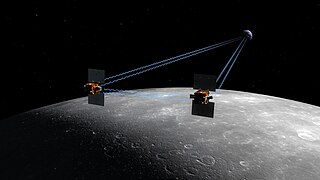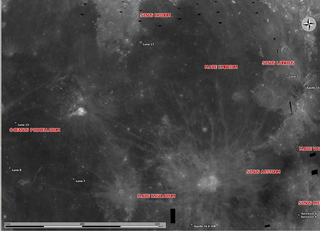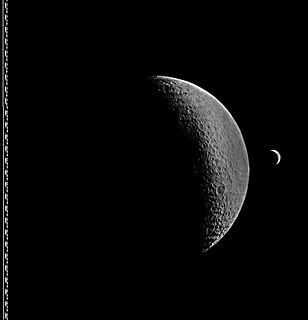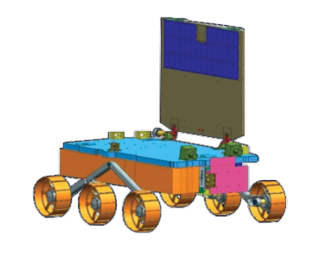 W
WThis is a partial list of artificial materials left on the Moon, many during the missions of the Apollo program. The table below does not include lesser Apollo mission artificial objects, such as a hammer and other tools, retroreflectors, Apollo Lunar Surface Experiments Packages, or the commemorative, artistic, and personal objects left by the twelve Apollo astronauts, such as the United States flags, the commemorative plaques attached to the ladders of the six Apollo Lunar Modules, the silver astronaut pin left by Alan Bean in honor of Clifton C. Williams whom he replaced, the Bible left by David Scott, the Fallen Astronaut statuette and memorial plaque placed by the crew of Apollo 15, the Apollo 11 goodwill messages disc, or the golf balls Alan Shepard hit during an Apollo 14 moonwalk.
 W
WBeresheet was a demonstrator of a small robotic lunar lander and lunar probe operated by SpaceIL and Israel Aerospace Industries. Its aims included inspiring youth and promoting careers in science, technology, engineering, and mathematics (STEM), and landing its magnetometer, time capsule, and laser retroreflector on the Moon. The lander's gyroscopes failed on 11 April 2019 causing through a series of failures main engine to shut off, which caused the lander to crash on the Moon. Its final resting position is 32.5956°N, 19.3496°E.
 W
WChandrayaan-2 is the second lunar exploration mission developed by the Indian Space Research Organisation (ISRO), after Chandrayaan-1. it consists of a lunar orbiter, and also included the Vikram lander, and the Pragyan lunar rover, all of which were developed in India. The main scientific objective is to map and study the variations in lunar surface composition, as well as the location and abundance of lunar water.
 W
WChang'e 1 was an unmanned Chinese lunar-orbiting spacecraft, part of the first phase of the Chinese Lunar Exploration Program. The spacecraft was named after the Chinese Moon goddess, Chang'e.
 W
WThe Gravity Recovery and Interior Laboratory (GRAIL) was an American lunar science mission in NASA's Discovery Program which used high-quality gravitational field mapping of the Moon to determine its interior structure. The two small spacecraft GRAIL A (Ebb) and GRAIL B (Flow) were launched on 10 September 2011 aboard a single launch vehicle: the most-powerful configuration of a Delta II, the 7920H-10. GRAIL A separated from the rocket about nine minutes after launch, GRAIL B followed about eight minutes later. They arrived at their orbits around the Moon 25 hours apart. The first probe entered orbit on 31 December 2011 and the second followed on 1 January 2012. The two spacecraft impacted the Lunar surface on December 17, 2012.
 W
WThe Hiten Spacecraft, given the English name Celestial Maiden and known before launch as MUSES-A, part of the MUSES Program, was built by the Institute of Space and Astronautical Science of Japan and launched on January 24, 1990. It was Japan's first lunar probe, the first robotic lunar probe since the Soviet Union's Luna 24 in 1976, and the first lunar probe launched by a country other than the Soviet Union or the United States.
 W
WThe Lunar Atmosphere and Dust Environment Explorer was a NASA lunar exploration and technology demonstration mission. It was launched on a Minotaur V rocket from the Mid-Atlantic Regional Spaceport on September 7, 2013. During its seven-month mission, LADEE orbited around the Moon's equator, using its instruments to study the lunar exosphere and dust in the Moon's vicinity. Instruments included a dust detector, neutral mass spectrometer, and ultraviolet-visible spectrometer, as well as a technology demonstration consisting of a laser communications terminal. The mission ended on April 18, 2014, when the spacecraft's controllers intentionally crashed LADEE into the far side of the Moon, which, later, was determined to be near the eastern rim of Sundman V crater.
 W
WThe Lunar Crater Observation and Sensing Satellite (LCROSS) was a robotic spacecraft operated by NASA. The mission was conceived as a low-cost means of determining the nature of hydrogen detected at the polar regions of the Moon. Launched immediately after discovery of lunar water by Chandrayaan-1, the main LCROSS mission objective was to further explore the presence of water in the form of ice in a permanently shadowed crater near a lunar polar region. It was successful in confirming water in the southern lunar crater Cabeus.
 W
WLuna 7 was an unmanned space mission of the Soviet Luna program, also called Lunik 7. The Luna 7 spacecraft was intended to achieve a soft landing on the Moon. However, due to premature retrofire and cutoff of the retrorockets, the spacecraft impacted the lunar surface in Oceanus Procellarum.
 W
WLuna 8, also known as Lunik 8, was a lunar space probe of the Luna program. It was launched in on 3 December 1965 with the objective of achieving a soft landing on the Moon; however, its retrorocket firing occurred too late, and suffered a hard impact on the lunar surface on the Oceanus Procellarum. The mission did complete the experimental testing of its stellar-guidance system and the ground-control of its radio telemetry equipment, its flight trajectory, and its other instrumentation.
 W
WLuna 15 was a robotic space mission of the Soviet Luna programme, that crashed into the Moon on 21 July 1969.
 W
WThe Lunar Orbiter 1 robotic spacecraft, part of NASA's Lunar Orbiter program, was the first American spacecraft to orbit the Moon. It was designed primarily to photograph smooth areas of the lunar surface for selection and verification of safe landing sites for the Surveyor and Apollo missions. It was also equipped to collect selenodetic, radiation intensity, and micrometeoroid impact data.
 W
WThe Lunar Orbiter 2 robotic spacecraft, part of the Lunar Orbiter Program, was designed primarily to photograph smooth areas of the lunar surface for selection and verification of safe landing sites for the Surveyor and Apollo missions. It was also equipped to collect selenodetic, radiation intensity, and micrometeoroid impact data.
 W
WThe Lunar Orbiter 3 was a spacecraft launched by NASA in 1967 as part of the Lunar Orbiter Program. It was designed primarily to photograph areas of the lunar surface for confirmation of safe landing sites for the Surveyor and Apollo missions. It was also equipped to collect selenodetic, radiation intensity, and micrometeoroid impact data.
 W
WLunar Orbiter 4 was a robotic U.S. spacecraft, part of the Lunar Orbiter Program, designed to orbit the Moon, after the three previous orbiters had completed the required needs for Apollo mapping and site selection. It was given a more general objective, to "perform a broad systematic photographic survey of lunar surface features in order to increase the scientific knowledge of their nature, origin, and processes, and to serve as a basis for selecting sites for more detailed scientific study by subsequent orbital and landing missions". It was also equipped to collect selenodetic, radiation intensity, and micrometeoroid impact data. The spacecraft was placed in a cislunar trajectory and injected into an elliptical near polar high lunar orbit for data acquisition. The orbit was 2,706 by 6,111 kilometres with an inclination of 85.5 degrees and a period of 12 hours.
 W
WLunar Orbiter 5, the last of the Lunar Orbiter series, was designed to take additional Apollo and Surveyor landing site photography and to take broad survey images of unphotographed parts of the Moon's far side. It was also equipped to collect selenodetic, radiation intensity, and micrometeoroid impact data and was used to evaluate the Manned Space Flight Network tracking stations and Apollo Orbit Determination Program. The spacecraft was placed in a cislunar trajectory and on August 5, 1967 was injected into an elliptical near polar lunar orbit 194.5 by 6,023 kilometres with an inclination of 85 degrees and a period of 8 hours 30 minutes. On August 7 the perilune was lowered to 100 kilometers (62 mi), and on August 9 the orbit was lowered to a 99-by-1,499-kilometer, 3 hour 11 minute period.
 W
WLunar Prospector was the third mission selected by NASA for full development and construction as part of the Discovery Program. At a cost of $62.8 million, the 19-month mission was designed for a low polar orbit investigation of the Moon, including mapping of surface composition including polar ice deposits, measurements of magnetic and gravity fields, and study of lunar outgassing events. The mission ended July 31, 1999, when the orbiter was deliberately crashed into a crater near the lunar south pole, after the presence of water ice was successfully detected.
 W
WThe Moon Impact Probe (MIP) developed by the Indian Space Research Organisation (ISRO), India's national space agency, was a lunar probe that was released by ISRO's Chandrayaan-1 lunar remote sensing orbiter which in turn was launched, on 22 October 2008, aboard a modified version of ISRO's Polar Satellite Launch Vehicle. It discovered the presence of water on the Moon.
 W
WPragyan was the rover of Chandrayaan-2, a lunar mission developed by the Indian Space Research Organisation (ISRO), that launched in July 2019. Pragyan was destroyed along with its lander, Vikram, when it crash-landed on the Moon in September 2019 and never got the chance to deploy.
 W
WRanger 4 was a spacecraft of the Ranger program, launched in 1962. It was designed to transmit pictures of the lunar surface to Earth stations during a period of 10 minutes of flight prior to crashing upon the Moon, to rough-land a seismometer capsule on the Moon, to collect gamma-ray data in flight, to study radar reflectivity of the lunar surface, and to continue testing of the Ranger program for development of lunar and interplanetary spacecraft.
 W
WRanger 6 was a lunar probe in the Ranger program, a robotic spacecraft series launched by NASA in the early and mid-1960s to obtain the first close-up images of the Moon's surface. It was designed to achieve a lunar impact trajectory and to transmit high-resolution photographs of the lunar surface during the final minutes of flight up to impact. The spacecraft carried six television vidicon cameras - two wide-angle and four narrow-angle - to accomplish these objectives. The cameras were arranged in two separate chains, or channels, each self-contained with separate power supplies, timers, and transmitters so as to afford the greatest reliability and probability of obtaining high-quality television pictures. No other experiments were carried on the spacecraft. Due to a failure of the camera system, no images were returned.
 W
WRanger 7 was the first space probe of the United States to successfully transmit close images of the lunar surface back to Earth. It was also the first completely successful flight of the Ranger program. Launched on July 28, 1964, Ranger 7 was designed to achieve a lunar-impact trajectory and to transmit high-resolution photographs of the lunar surface during the final minutes of flight up to impact.
 W
WRanger 8 was a lunar probe in the Ranger program, a robotic spacecraft series launched by NASA in the early-to-mid-1960s to obtain the first close-up images of the Moon's surface. These pictures helped select landing sites for Apollo missions and were used for scientific study. During its 1965 mission, Ranger 8 transmitted 7,137 lunar surface photographs before it crashed into the Moon as planned. This was the second successful mission in the Ranger series, following Ranger 7. Ranger 8's design and purpose were very similar to those of Ranger 7. It had six television vidicon cameras: two full-scan and four partial-scan. Its sole purpose was to document the Moon's surface.
 W
WRanger 9 was a Lunar probe, launched in 1965 by NASA. It was designed to achieve a lunar impact trajectory and to transmit high-resolution photographs of the lunar surface during the final minutes of flight up to impact. The spacecraft carried six television vidicon cameras—two wide-angle and four narrow-angle —to accomplish these objectives. The cameras were arranged in two separate chains, or channels, each self-contained with separate power supplies, timers, and transmitters so as to afford the greatest reliability and probability of obtaining high-quality television pictures. These images were broadcast live on television to millions of viewers across the United States. No other experiments were carried on the spacecraft.
 W
WSELENE, better known in Japan by its nickname Kaguya (かぐや), was the second Japanese lunar orbiter spacecraft following the Hiten probe. Produced by the Institute of Space and Astronautical Science (ISAS) and the National Space Development Agency (NASDA), the spacecraft was launched on September 14, 2007. After successfully orbiting the Moon for a year and eight months, the main orbiter was instructed to impact on the lunar surface near the crater Gill on June 10, 2009.
 W
WSMART-1 was a Swedish-designed European Space Agency satellite that orbited around the Moon. It was launched on 27 September 2003 at 23:14 UTC from the Guiana Space Centre in Kourou, French Guiana. "SMART-1" stands for Small Missions for Advanced Research in Technology-1. On 3 September 2006, SMART-1 was deliberately crashed into the Moon's surface, ending its mission.
 W
WSurveyor 2 was to be the second lunar lander in the uncrewed American Surveyor program to explore the Moon. It was launched September 20, 1966 from Cape Kennedy, Florida aboard an Atlas-Centaur rocket. A mid-course correction failure resulted in the spacecraft losing control. Contact was lost with the spacecraft at 9:35 UTC, September 22.
 W
WSurveyor 4 was the fourth lunar lander in the American uncrewed Surveyor program sent to explore the surface of the Moon. This spacecraft crashed after an otherwise flawless mission; telemetry contact was lost 2.5 minutes before touchdown. The planned landing target was Sinus Medii at 0.4° north latitude and 1.33° west longitude.